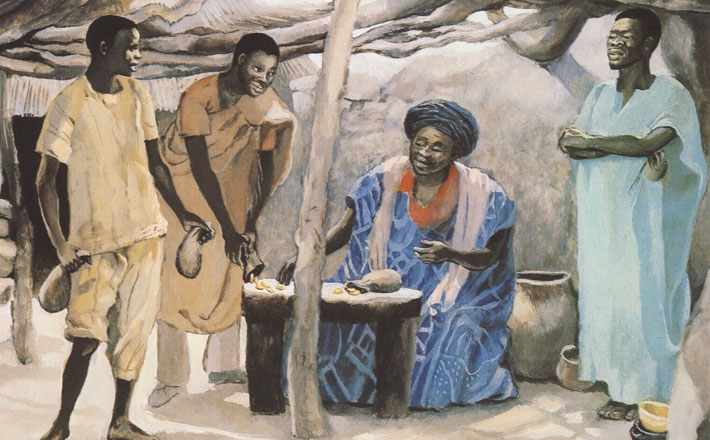Commentary on Matthew 25:14-30
The end is near! The year of Matthew is drawing to a close.
Now we preachers find ourselves mired in eschatological parables. We are likely uncomfortable with Matthew’s apocalyptic language this season: the days are getting shorter and his lections are getting darker. Yet we need to remember Matthew’s own eschatological agenda.
The Matthean Jesus named Immanuel, God with us, in Matthew 1 is the same Christ who meets us in troubling texts “until the end of the age.” The same Jesus who embraces the Father’s prevenient grace in the lilies of the field holds tightly to an exceeding righteousness in the works of his disciples in the Sermon on the Mount. The end is near in eschatological parables, but it is the same confounding Matthean Parabler who narrates them.
Therefore, preachers need to recognize that the Matthew’s gospel is not Mark, or Luke, or even Paul’s. Part of our discomfort with Matthew’s eschatological parables is not just with the sulfuric whiff of apocalyptic that accompanies them, but the troubling theology of the Matthean gospel itself. More than the other synoptics, I would argue, Matthew holds that judgment and ultimate exclusion are (after)living options for those who fail to translate words into deeds.
Here in the eschatological parables, and in other Matthean lections, we run into judgment in the form of weeping and gnashing of teeth and exclusion from wedding feasts. This pronounced theological horizon of judgment seems far from our world these days and does not comport well with the cozy glow of churchy stained glass windows and padded pews. Part of the problem of Matthew’s eschatological parables is the Gospel’s willingness to give judgment its due as an ultimate goad for good works.
With these theological tensions in mind — both Matthew’s own and ours — we turn to the parable of the talents in Matthew 25:14-30. Because I am a person who tends to score a “G” on the Grace/Judgment scale, I am inclined to focus on the front half of the parable. The master gives talents. I am tempted as a person with some degree of power and privilege to foreground those talents theologically and downplay the rest of the text: God, the master, gives gifts; we steward them. The strange thing is that the text seems to move toward the end rhetorically.
The master does indeed give talents, but the text presupposes an economic system of slavery and a master who uses slaves in his absence as means of turning a profit on the great wealth he already owns. The rhetorical accent of the text is not so much on the first two slaves who are successful and get to enter the master’s joy. In fact, about the only difference between them is the number of talents they receive: 10 and 5, respectively. A close reading of the first two slaves shows a repetition, nearly word for word, about what they do and what happens to them.
The variant, the third slave in the sequence, receives quite a bit of discussion for someone who buries the single talent in the ground — literally, making a deposit. While the first two slaves are dispatched by Matthew 25:23, everything after verse 24 concerns itself with the third slave and the dialogue between him and the master. Rhetorically, the text wants us to dwell on the third slave, his conversation with the master, and his fate in ultimate judgment. Matthew focuses on the back half of the parable: useless slave, outer darkness, wailing and gnashing of teeth.
One could, of course, resist Matthew’s theology and back loaded rhetoric. The idea of identifying God as a slave master is plenty problematic. The apocalyptic overlay of Parousia and judgment offers its own problems, too, and demythologizing with Bultmann only gets you so far. It might just be tempting to walk away — just preach “against the text” or don’t preach it at all.
But Matthew wants to give us something to reflect on. We may not need to accept Matthew’s answer, but perhaps we can benefit from working through Matthew’s way of portraying the problem. I mentioned above that Matthew has his own unique eschatological vision. He doesn’t follow apocalyptic slavishly — apocalyptic language lurks here mostly on the edges. Ultimate judgment is barely evoked, not graphically depicted as in your run-of-the-mill apocalypses like Enoch and Revelation. Matthew is much more interested in using ultimate judgment as a future/present, as a way of encouraging an engagement with rather than a burying of talents. One other apocalyptic feature is the premise underlying the parable: the returning master.
The metaphor is inadequate, but does capture in part the experience of absence of the early Church. What the church does in this crucial time between resurrection and Parousia is key. Theologian Sallie McFague argues that metaphors have an is/is not quality.1 The “is” of this metaphor is the absence of the master who nonetheless has “entrusted his property to them” (Matthew 25:14) and intends to return to settle accounts. And yet, this parable is narrated by the Parabler, Jesus Messiah himself, the one who since Matthew 1:1 is both “Son of Abraham” and “Son of David”; the one through whom God’s broadest and most royal promises have even now under the crucifying Empire are coming to fulfillment.
For all the difficulties of this parable, its vision of Parousia helps figure Jesus’ absence and promised return. To that limited extent, its metaphor helps as a goad for faithfulness in the present. And we all know how Matthew feels about words and faithful deeds — they’re ultimately inseparable.
So the last remaining issue for preachers is theological. What are we to do with judgment as Matthew’s ultimate goad to faithful action? Biblical scholar and Lutheran bishop Krister Stendahl reminds us in a brilliant essay that God’s judgment is deeply related to divine justice and mercy. We with varying degrees of privilege binary such things at our peril and fail to discern the full mystery of the gospel.2
Indeed, Luther himself acknowledges how both difficult and important it is to discern gospel aright.3 Perhaps, then, this Sunday is a great day to take up the unfinished task of theology in preaching in “differentiated proximity” to Matthew: to speak of judgment, faithful action, and yes, grace in light of our own local struggles and yet in the very presence of the confounding Parabler whom Matthew also calls Immanuel, God with us, even to the end of the age.
Notes
1. Sallie McFague, Metaphorical Theology (Philadelphia: Fortress, 1982).
2. Krister Stendahl, “Judgment and Mercy,” in God among Jews and Gentiles (Philadelphia: Fortress, 1976), 97-108.
3. Luther says in the Table Talk that only God in the Holy Spirit truly knows how to distinguish law and gospel, Luther’s Works vol. 54, 127.


November 19, 2017